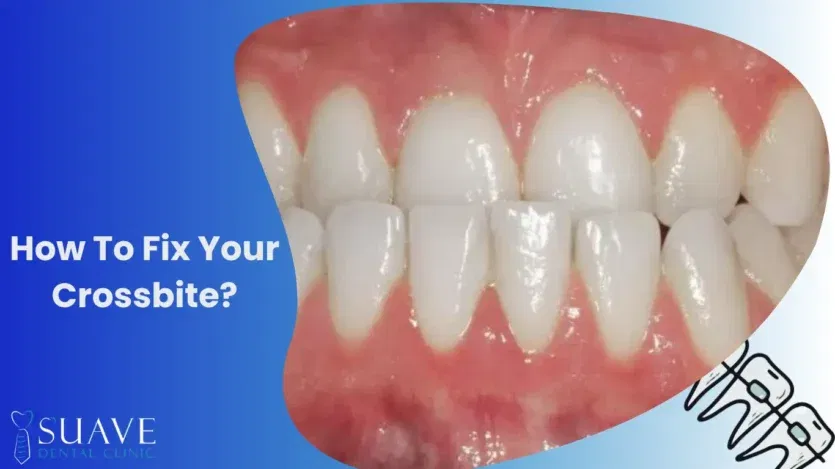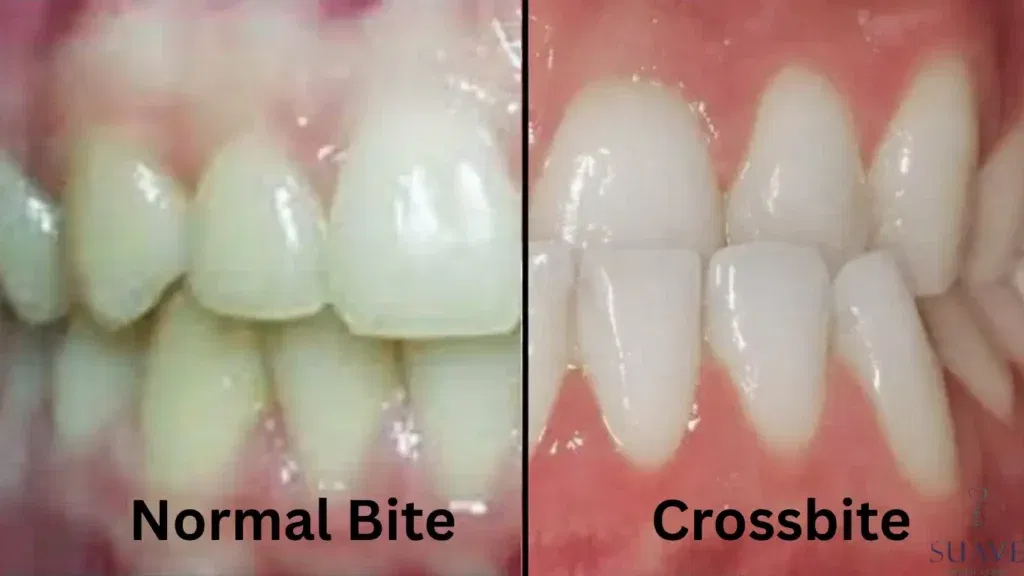
Table of Contents
Being an adult with a crossbite malocclusion not only affects your appearance; you may face multiple problems, ranging from aesthetic concerns to jaw pain, bite difficulties, and other dental issues that can bother you throughout your life.
In this article, you’ll learn what a crossbite smile really means, how it can affect your daily life, and what you can do to fix it and prevent it from getting worse.
What is a crossbite?
To understand what a problem is, you first need to know what normal occlusion looks like. In normal occlusion, your upper teeth are slightly wider and overlap the lower teeth from the outside to ensure proper alignment and balanced chewing.
Crossbite malocclusion happens when this balance is lost. It is a type of dental malocclusion that can affect one tooth or multiple teeth. This condition causes the upper teeth to sit behind or inside the lower teeth when you bite down.
Normal occlusion allows chewing forces to spread evenly. But with this malocclusion, this balance is lost, which may lead to uneven wear and damage over time.
Types of crossbite
- Anterior crossbite
If only some upper front teeth fall behind the lower ones, it’s a crossbite. When all upper front teeth sit behind the lower front teeth, that’s called an “underbite.”
While a crossbite usually affects only some teeth, an underbite affects the entire front bite and often means that the lower jaw is more prominent than normal. - Posterior crossbite
This happens when the upper back teeth are tilted towards the tongue, causing them to fit inside the lower back teeth when you bite down.
It can affect only one side of the jaw or both. Each person’s case is unique, depending on how many teeth are involved and how severe the misalignment is.
Crossbite symptoms and diagnosis
The patient’s main complaint is usually about their teeth not aligning properly. This misalignment can lead to several noticeable symptoms, like
- Tooth decay
- Enamel Wear
- Speech problem
- Improper chewing
- Tongue and cheek biting
- Severe Headache
- Temporomandibular jaw disorders (TMD)
Diagnosis begins when the patient visits the clinic with one or more related symptoms. The dentist starts to examine the teeth, jaws, and occlusion carefully to determine the type and severity of the case. A good diagnosis helps in choosing the most suitable treatment plan for each case.

What are the causes of crossbite?
It can be caused by a mix of habits, dental issues, skeletal problems, or genetics—sometimes all of them. Common causes include:
- Childhood Bad Habits
- Pacifier teeth and Thumb Sucking
- Mouth breathing
- Tongue thrust
- Skeletal problem
- Cleft lip and palate
- Abnormal jaw growth
- Dental problem
- Missing teeth
- Early baby loss
- Delayed eruption of adult teeth
- Big teeth in relation to the jaw
- Genetics
Skeletal and dental causes may be genetic.
These factors can exert excessive pressure, forcing teeth out of position and modifying bone formation, causing structural and alignment issues.
Do I need to correct my crossbite teeth?
Because it is more than just a cosmetic issue, it can lead to several problems that impact your daily life; it can affect overall dental hygiene. That’s why early treatment is important, as a crossbite smile won’t fix itself without professional care.
What complications can a crossbite cause?
If this malocclusion is left untreated, this could lead to complications like
- Mandibular shift
- Facial asymmetry
- Excessive Enamel Wear
- Gum disease, like periodontitis, may cause bone loss and tooth loss
- Loose teeth
- Sleep apnea
- Jaw, neck, and shoulder muscle pain
- Low self-confidence
How is a crossbite corrected?
Treatment options vary based on the patient’s age, how many teeth are involved, and how severe the case is.
That’s why it’s important to understand how treatment differs for children, toddlers, and adults.
1- Crossbite in kids
It can often be treated before the age of 10, while the jawbone is still growing, making it easier to manipulate using simple orthodontic appliances. The results usually appear faster compared to treatment after the age of 10.
2- Crossbite in toddlers
For toddlers, treatment often focuses on removing the cause first – such as stopping habits like thumb sucking – and monitoring jaw development. In some cases, simple appliances may be used if it does not correct themselves naturally as the child grows.
3- Crossbite in adults
For adults, treatment is challenging and usually takes longer, from 18 up to 5 years, depending on the severity of the case. Correction may involve multiple steps, including tooth extraction, braces, orthodontic appliances, elastics, and Invisalign to retain the results.
4- Genetic Crossbite
Skeletal malocclusion that is genetically caused by the regression of the upper jaw and protrusion of the lower jaw bones, creating that reversed bite. This isn’t simply treated by orthodontic treatment, instead, it’s treated by orthognathic surgery specially at the age pre-adulthood.
How much does corrective treatment cost?
Costs vary widely depending on the age, treatment type, and how soon you start. Early treatment is always more affordable.
Here’s a rough order from least to most expensive:
- Orthodontic appliance
- Braces
- Jaw surgery
How can you prevent a crossbite or stop it from worsening?
While not all crossbites can be prevented—especially genetic ones—there are things you can do to lower the risk:
- Take your child for their first orthodontic check-up by age 7.
- Avoid prolonged pacifier or thumb sucking.
- Motivate your child to use their nose for breathing.
- Treat mouth breathing or tongue thrusting early.
- Schedule regular dental visits to monitor growth and tooth eruption.
A crossbite isn’t something that needs urgent care, but ignoring it can lead to more complicated treatment.
Early correction supports natural jaw growth and stops minor bite issues from becoming major ones later. The American Association of Orthodontists (AAO) advises that children receive an orthodontic assessment by age 7 to identify potential oral irregularities at an early stage and protect their smile for years to come.
Crossbite Teeth FAQs
Can Invisalign correct a crossbite?
Yes, Invisalign can correct mild cases, but its effectiveness depends on factors such as your age, the type, and how severe the misalignment is.
Does fixing a crossbite change face shape?
Since this condition can affect the jaw’s alignment and lead to facial asymmetry, correcting it will definitely help improve facial balance and enhance your overall appearance.
Can I fix a crossbite without surgery?
Yes, you can fix it, but it depends on the cause of crossbite misalignment whether it’s dental or skeletal, your age and how bad the case is. The earlier you start treatment, the easier it will be, and you may avoid surgery.
If it is of a skeletal cause, then crossbite teeth correction, unfortunately, will be surgical.
References
Medically Reviewe